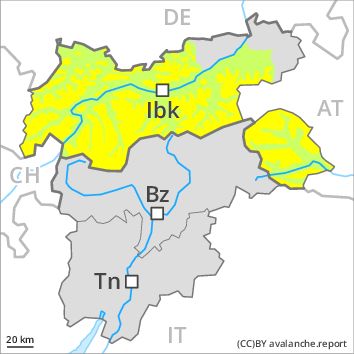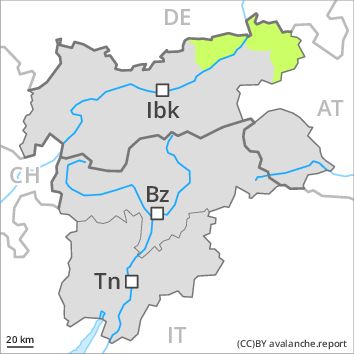Regions
Western Verwall Mountains, Eastern Verwall Mountains, Silvretta, Samnaun Mountains, Northern Oetz and Stubai Alps, Western Tuxer Alps, Eastern Tuxer Alps, Western Kitzbühel Alps, Glockturm Range, Weißkugel Range, Gurgler Range, Central Stubai Alps, Northern Zillertal Alps, Allgäu Alps, Venediger Range, Eastern Lechtal Alps - Ammergau Alps, Mieming Mountains, Eastern Rieserferner Mountains, Karwendel Mountains, Glockner Range, Eastern Deferegger Alps, Schober Mountains, Lienzer Dolomites, Western Lechtal Alps, Central Lechtal Alps, Grieskogel Mountains

Danger level
Avalanche Problem
Wind-drifted snow above 2200m, N-NE-E-W-NW

Wind slabs represent the main danger. Caution is to be exercised in particular on very steep shady slopes above approximately 2200 m adjacent to ridgelines and in gullies and bowls.
Since Friday extensive wind slabs formed adjacent to ridgelines and in gullies and bowls. They are clearly recognisable to the trained eye. Caution is to be exercised in particular on very steep shady slopes above approximately 2200 m. Mostly avalanches are rather small and can mostly be released by large loads. At high altitudes and in high Alpine regions the avalanche prone locations are more prevalent and larger.
Weak layers in the upper part of the snowpack can be released on very steep sunny slopes, especially between approximately 2300 and 2800 m. These avalanche prone locations are rare and are barely recognisable, even to the trained eye. Avalanches are only small.
In addition a latent danger of gliding avalanches exists, in particular in the regions with a lot of snow as well as along the border with Vorarlberg.
Snow sport activities outside marked and open pistes call for experience in the assessment of avalanche danger and a certain restraint.
Snowpack
dp 6: cold, loose snow and wind
dp 4: cold following warm / warm following cold
The fresh and older wind slabs are lying on soft layers in particular on shady slopes at intermediate and high altitudes. These have bonded quite well with the old snowpack. Faceted weak layers exist in the top section of the old snowpack on steep sunny slopes. These can in very isolated cases be released, in particular by large loads. The snowpack will be moist at low altitude.
Tendency
The avalanche danger will persist.
